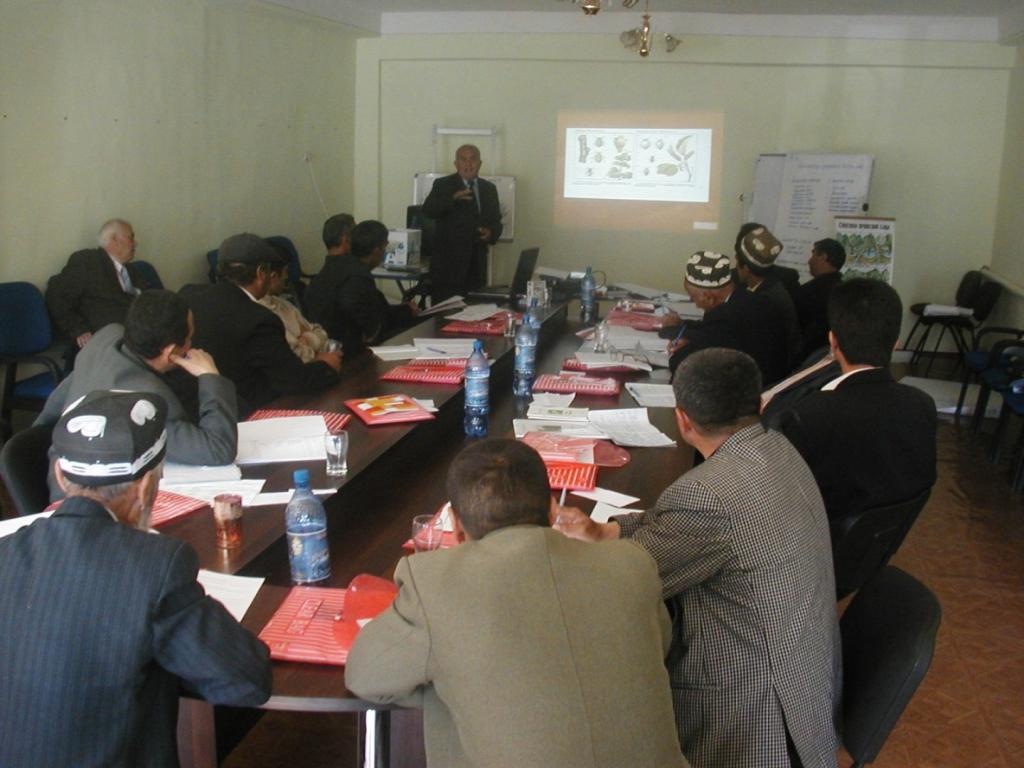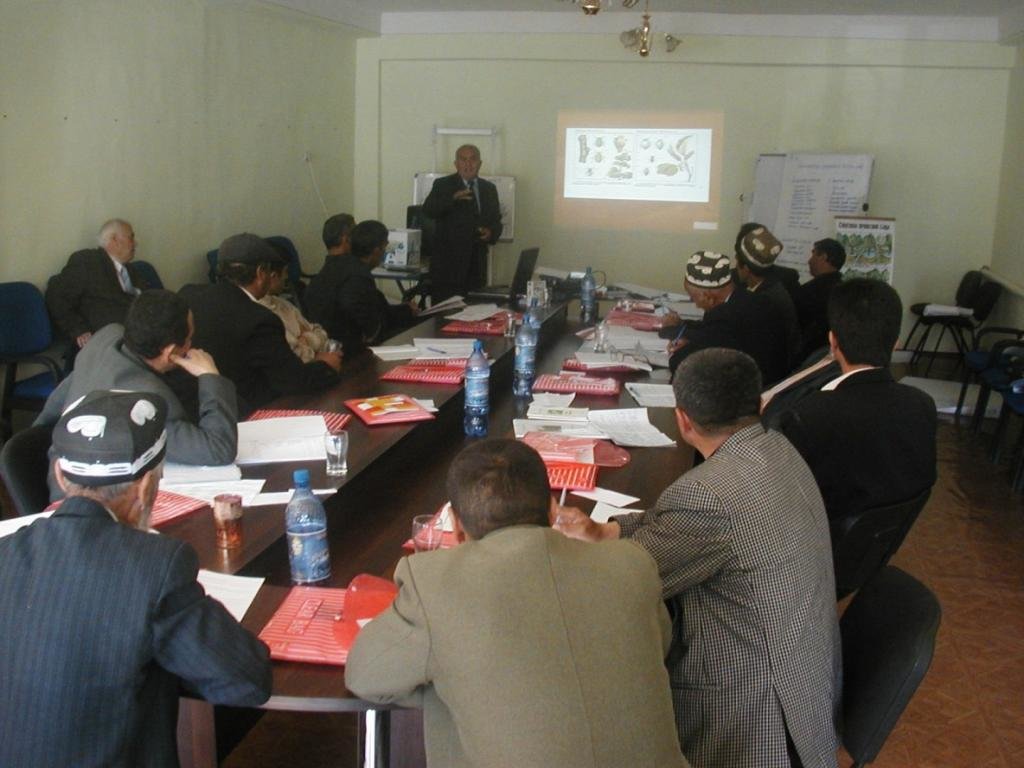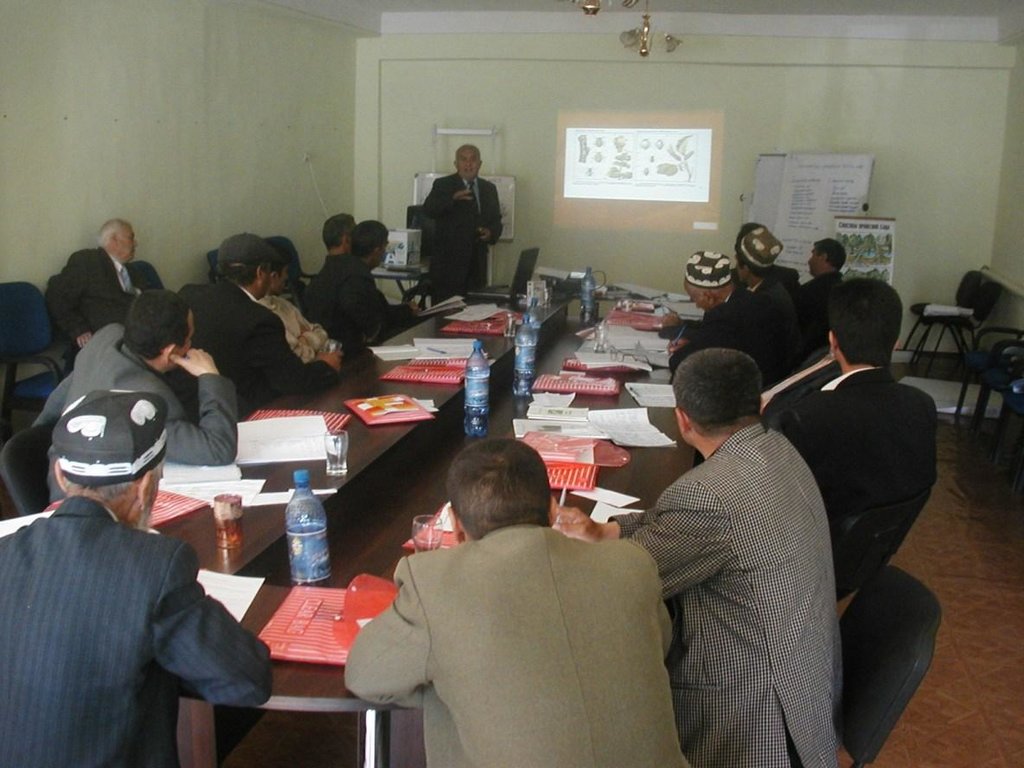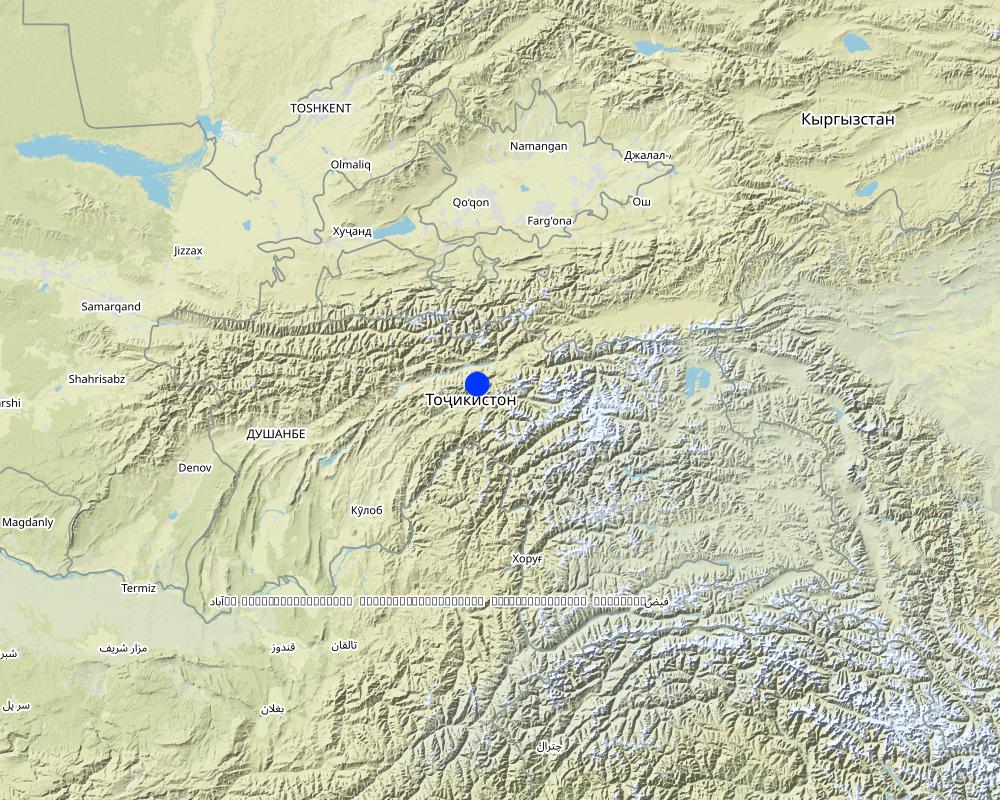Facilitation of community-based pasture management initiatives [Тажикистан]
- Шинийг нээх:
- Шинэчлэх:
- Мэдээлэл цуглуулсан: Mizrob Amirbekov
- Редактор: –
- Хянагчид: David Streiff, Alexandra Gavilano, Joana Eichenberger
Mountain Societies Development Support Programme - Aga Khan Foundation
approaches_2444 - Тажикистан
Бүлгүүдийг үзэх
Бүгдийг харуулах Бүгдийг хаах1. Ерөнхий мэдээлэл
1.2 Арга барилыг баримтжуулах болон үнэлгээ хийхэд оролцсон хүн эсвэл байгууллагын холбоо барих хаяг
ГТМ мэргэжилтэн :
Pachova Nevelina
Palm
Арга барилыг баримтжуулах/үнэлэх ажилд дэмжлэг үзүүлсэн төслийн нэр (шаардлагатай бол)
Sustainable Land Management in the High Pamir and Pamir-Alai Mountains (PALM Project / NCCR)Арга барилыг баримтжуулах/үнэлэх ажилд дэмжлэг үзүүлсэн төслийн нэр (шаардлагатай бол)
Pilot Program for Climate Resilience, Tajikistan (WB / PPCR)Арга барилыг баримтжуулах/үнэлэх ажилд дэмжлэг үзүүлсэн байгууллага(ууд)-ын нэр (шаардлагатай бол)
Kyrgyzstan Mountain Societies Development Support Programme, Aga Khan Development Network (MSDSP KG) - Киргизстан1.3 WOCAT-аар баримтжуулсан өгөгдлийг ашиглахтай холбоотой нөхцөл
Эмхэтгэгч болон гол мэдээлэгч хүн(хүмүүс) WOCAT аргачлалаар баримтжуулсан мэдээллийг ашиглахтай холбоотой нөхцлийг хүлээн зөвшөөрсөн.
Тийм
2. ГТМ Арга барилын тодорхойлолт
2.1 Арга барилын товч тодорхойлолт
Initiation of community-based solutions to slow down pasture degradation, and to improve pasture use and management in three pilot Jamoats of upland Tajikistan.
2.2 Арга барилын дэлгэрэнгүй тодорхойлолт
Арга барилын дэлгэрэнгүй тодорхойлолт :
Aims / objectives: During the Soviet times land users in Tajikistan were allowed to keep very little livestock individually and this was mainly in the vicinity of rural settlements. The majority of the livestock were managed by collective agricultural farms, which utilised different seasonal pastures. After the collapse of the Soviet Union, the previously state-owned livestock was distributed among individual farmers, most of whom had limited knowledge and experience with pasture management (PM), and capacities to access the distant pastures used by the collective farms. As a consequence, the amount of livestock kept in the vicinity of rural settlements increased, leading to overgrazing and severe degradation of nearby pastures. In the framework of a project on sustainable land management in the Pamir-Alai region (PALM), funded by the Global Environment Facility (GEF), MSDSP facilitated the initiation of community-based solutions to the problem of pasture degradation at three pilot jamoats in Jirgital, and three in Gorno-Badakhshan Autonomous Oblast (GBAO).
Methods: 1. Awareness raising and capacity building of PM issues. 2. Integration of PM issues in village development plans. 3. Grant support and community co-financing for implementation of targeted measures. 4. Monitoring of the impacts of the implemented measures as a basis for up-scaling.
Stages of implementation: 1. National pasture management experts from the Pamir Biological Institute held a training of trainers (ToT) session for MSDSP facilitators and district specialists, who conducted follow-up training on PM at the pilot communities in 2009. 2. Pilot communities identified key problems related to PM in the process of Village Development Planning facilitated by MSDSP, and prioritised targeted measures for improved PM. 3. A set of micro-project proposals were developed based on the prioritised measures, which focused on (re-) construction of roads and bridges for improved access to pastures, and construction of stables during spring/autumn, as well as summer pastures. 4. Monitoring of the impacts of the implemented measures as a basis for up-scaling.
Role of stakeholders: Community members were engaged in identifying and implementing targeted measures for addressing pasture use and management issues. Jamoat level non-governmental organisations called Social Unions for Development of Village Organizations (SUDVOs), coordinated and supported the identification and implementation of the selected projects in several village organisations. Governmental agricultural extension agents were engaged in training, and consulted in the review process. MSDSP staff facilitated the overall process and engaged in monitoring progress with implementation. PALM project staff engaged in the review, monitoring and assessment of the impacts of the supported measures.
2.3 Арга барилын зурагууд
2.5 Арга барил нэвтрүүлсэн улс орон / бүс нутаг / байршил
Улс :
Тажикистан
Байршлын дэлгэрэнгүй тодорхойлолт:
Jirgatol
Тайлбар:
Three pilot jamoats in the Jirgital region (Jirgital, Pildon and Yangishar), and three in Gorno-Badakhshan Autonomous Oblast (GBAO), (Shitharv, Vankala and Alichur) were covered by the approach
Map
×2.6 Арга барилыг эхлэх, дуусах огноо
Эхлэх жилийг тэмдэглэ:
2009
2.7 Арга барилын төрөл
- төсөл / хөтөлбөр дээр үндэслэсэн
2.8 Арга барилын үндсэн зорилго, зорилтууд
The Approach focused mainly on SLM with other activities (rehabilitation of rural infrastructure to improve access to pastures, pasture and livestock productivity, animal diseases)
The main aim of the approach was to initiate the improved use and management of pastures, by raising awareness and knowledge on issues regarding pasture degradation and sustainable pasture management, mobilising community action, and pilot-testing selected technologies and measures for improving pasture management in highly degraded areas.
The SLM Approach addressed the following problems: pasture degradation, overgrazing, restricted pasture area and too many cattle garzing, lack of infrastructure (bridges, roads, shelters), lack of knowledge about pasture management
2.9 Арга барилын хүрээнд хэрэгжсэн Технологи/Технологиудад дэмжсэн эсвэл саад учруулсан нөхцлүүд
санхүүгийн нөөц, үйлчилгээний хүртээмж / боломж
- Хазаарлалт
communities were lacking funds for infrastructure development and could therefore not invest in the construction of roads and bridges
Treatment through the SLM Approach: GEF funds were used to support communities in financing infrastructural improvements which allowed for more productive and sustainable use of available pasture resources
Бүтэц зохион байгуулалт
- Хазаарлалт
Lack of capacity to deal with pasture degradation problems
Treatment through the SLM Approach: Engagement of village organisations, and social unions of village organisations (SUDVO) in addressing pasture management issues at six pilot jamoats
Хууль, эрхзүйн хүрээ (газар эзэмшил, газар, ус ашиглах эрх)
- Хазаарлалт
Limited clarity regarding responsibilities and lack of incentives for sustainable pasture management
Treatment through the SLM Approach: MSDSP and PALM project members recommended the development of a pasture management law that addresses those legal constrains
The existing land ownership, land use rights / water rights moderately hindered the approach implementation there is no law about pasture management in Tajikistan, therefore it was difficult to regulate the process
ГТМ-ийн талаарх мэдлэг, техникийн дэмжлэг авах боломж
- Хазаарлалт
technical knowledge about pasture management was lacking as during Soviet times people were not allowed to keep a lot of livestock
Treatment through the SLM Approach: Community members of village organisations and relevant government experts were trained in various issues of pasture management
3. Оролцогч талуудын оролцоо ба үүргүүд
3.1 Арга барилд оролцогч талууд болон тэдгээрийн үүргүүд
- Орон нутгийн газар ашиглагч / орон нутгийн иргэд
Village organisations
Only 20% of the participants were women, since men are responsible for managing the livestock, while women are concerned with livestock products only
Elderly members of the communities were engaged in discussions on the possible solutions
- ГТМ-ийн мэргэжилтэн/ хөдөө аж ахуйн зөвлөх
Governmental agricultural advisors participated in the training.
- Засгийн газар (шийдвэр гаргагч, төлөвлөгч)
Agrarian University in Jirgatol, Pamir Biological Institute
- pilot communities
3.2 Арга барилын янз бүрийн үе шатанд орон нутгийн газар ашиглагчид / бүлэглэлүүдийг татан оролцуулах
| Орон нутгийн газар ашиглагч / орон нутгийн иргэдийн оролцоо | Хэн оролцсоныг тодорхойлж, үйл ажиллагааг тайлбарлана уу | |
|---|---|---|
| санаачлага/идэвхжүүлэлт | үгүй | |
| Төлөвлөгөө | интерактив | Members of village organisations were involved in training and planning on pasture management, and actively participated in discussions |
| Хэрэгжилт | өөрийн хүчийг нэгтгэсэн | The village organisations developed their own project ideas and submitted those proposals to MSDSP and other funders |
| Мониторинг/ үнэлгээ | интерактив | Land users were engaged in the monitoring and evaluation of the impacts of the implemented projects |
| Research | интерактив | The Pamir-Biological Institute and the Institute of Botany under the Academy of Sciences were engaged in research and technical consultations |
3.4 ГТМ-ийн технологи/технологиуд сонгох шийдвэр
Технологи(д) сонгох шийдвэр гаргасан уу?
- pilot communities
Тайлбар :
Community members were engaged in identifying and implementing targeted measures for addressing pasture use and management issues.
Decisions on the method of implementing the SLM Technology were made by pilot communities and facilitators. Community members were engaged in identifying and implementing targeted measures for addressing pasture use and management issues.
4. Техникийн дэмжлэг, чадавхи бүрдүүлэх, мэдлэгийн менежмент
4.1 Чадавхи бэхжүүлэх/сургалт
Газар эзэмшигчид / бусад оролцогч талуудад сургалт явуулсан уу?
Тийм
Хэн сургалтанд хамрагдсан бэ:
- Газар ашиглагчид
- хээрийн ажилтан / зөвлөх
Сургалтын хэлбэр :
- курс дамжаа
Хамрагдсан сэвдүүд:
Short training courses were provided for land user, field staff/agricultural advisors
4.2 Зөвлөх үйлчилгээ
Газар ашиглагчдад зөвлөх үйлчилгээ авах боломжтой байдаг уу?
Тийм
- through trained experts
Тодорхойлолт / тайлбар:
Name of method used for advisory service: Engineering support and technical consultations
Advisory service is quite adequate to ensure the continuation of land conservation activities
4.3 Институцийг бэхжүүлэх (байгууллагын хөгжил)
Арга барилаар дамжуулан институц байгуулагдаж эсвэл бэхжсэн үү?
- Тийм, маш их
Байгууллагууд бэхжиж, үүсэн бий болсон түвшин(үүд)-г тодорхойлно уу:
- Орон нутгийн
Дэмжлэгийн төрлийг ялга:
- чадавхи бэхжүүлэх / сургалт
Дэлгэрэнгүй мэдээллийг өгнө үү:
village organisations were trained
4.4 Мониторинг ба үнэлгээ
Мониторинг болон үнэлгээ нь арга барилын хэсэг үү?
Тийм
Тайлбар:
economic / production aspects were regular monitored by project staff through observations; indicators: changes in economic benefits for households before and after implementation of project
bio-physical aspects were regular monitored by project staff through observations; indicators: changes in vegetation coverage, edible grass species, etc.
area treated aspects were regular monitored by project staff through observations; indicators: Established at the start of project implementation
There were several changes in the Approach as a result of monitoring and evaluation: Some areas were grazed although they should not have been, project staff then talked to the responsible people in the village to ask about the causes for this and to try and initiate changes in practice.
4.5 Судалгаа
Судалгаа арга барилын хэсэг нь байсан уу?
Тийм
- pasture management
Дэлгэрэнгүй мэдээллийг өгч, хэн судалгаа явуулсныг бичнэ үү:
Aimed at problem, option and impact assessment
Research was carried out on-farm
5. Санхүүгийн болон гадаад материаллаг дэмжлэг
5.1 ГТМ-ийн Арга барилын бүрэлдэхүүн хэсгийн жилийн төсөв
Хэрэв жилийн төсөв тодорхойгүй бол хягаарыг тодруулна уу:
- 2,000-10,000
Тайлбар (жнь: санхүүжилтийн гол эх үүсвэр / гол хандивлагчид):
Approach costs were met by the following donors: international (PALM): 70.0%; national non-government (MSDSP): 30.0%
5.2 Газар ашиглагчдад санхүүгийн / материаллаг дэмжлэг үзүүлсэн
Технологи / технологийг хэрэгжүүлэхэд газар ашиглагчид санхүүгийн / материаллаг дэмжлэг авсан уу?
Үгүй
5.3 Тодорхой зардлыг даахад чиглэсэн дэмжлэгт (хөдөлмөрийн хүчийг оролцуулаад)
- Дэд бүтэц
| Ямар хөрөнгө оруулалт татаасаар олгогдсоныг заана уу | Ямар талбайн хэмжээнд | Тэтгэмж, урамшууллыг тодорхойлно уу |
|---|---|---|
| Зам | хэсэгчлэн санхүүждэг | |
| bridges, shelters | хэсэгчлэн санхүүждэг | |
Хэрэв газар ашиглагчийн хөдөлмөрийн хүч чухал байсан бол энэ нь аль хэлбэр байсан:
- сайн дурын
5.4 Кредит
Арга барилын хүрээнд ГТМ-ийн үйл ажиллагаанд зориулж зээлд хамрагдсан уу?
Үгүй
6. Нөлөөллийн дүн шинжилгээ ба дүгнэлт
6.1 Арга барилын нөлөөллүүд
Арга барил нь ГТМ-ийн технологийг хэрэгжүүлж, хадгалахад газар ашиглагчдад тусласан уу?
- Үгүй
- Тийм, бага зэрэг
- Тийм, зарим
- Тийм, их
Reduced pressures on pastures in the vicinity of rural settlements
Арга барил нь эмзэг бүлгийнхнийг нийгэм, эдийн засгийн хувьд чадавхижуулсан уу?
- Үгүй
- Тийм, бага зэрэг
- Тийм, зарим
- Тийм, их
Elderly herders with improved access to health facilities
Арга барил нь ГТМ-ийн технологийг хэрэгжүүлэхэд саад учруулсан газрын эзэмшил / ашиглах эрхийг сайжруулахад чиглэсэн үү?
- Үгүй
- Тийм, бага зэрэг
- Тийм, зарим
- Тийм, их
talks with the government were started to make way for a law on pasture management
Did other land users / projects adopt the Approach?
- Үгүй
- Тийм, бага зэрэг
- Тийм, зарим
- Тийм, их
Strong interest by other communities but limited financial means for replication
Did the Approach lead to improved livelihoods / human well-being?
- Үгүй
- Тийм, бага зэрэг
- Тийм, зарим
- Тийм, их
Improved access to fodder, reduced loss of livestock, etc
Did the Approach help to alleviate poverty?
- Үгүй
- Тийм, бага зэрэг
- Тийм, зарим
- Тийм, их
The primary beneficiaries are the groups with a medium income
6.2 ГТМ-ийг хэрэгжүүлэх газар ашиглагчидын гол санаачилга
- үйлдвэрлэл нэмэгдсэн
Increased pasture area and livestock productivity, reduced loss of livestock, reduced labour inputs
- Байгаль орчны ухамсар
Increased awareness of the degradation of pastures
- well-being and livelihoods improvement
Improved convenience, reduced conflicts over livestock tramping and grazing of croplands
6.3 Арга барилын үйл ажиллагааны тогтвортой байдал
Газар ашиглагчид арга барилаар дамжуулан хэрэгжүүлсэн арга хэмжээг тогтвортой хадгалж чадах уу (гадны дэмжлэггүйгээр)?
- Тийм
Хэрэв тийм бол яаж гэдгийг тайлбарлана уу:
The village organisations have the responsibility to teach their community members
6.4 Арга барилын тогтвортой/давуу тал/боломжууд
| Эмхэтгэгч, бусад мэдээлэл өгсөн хүмүүсийн өнцгөөс тодорхойлсон давуу тал/боломжууд |
|---|
| Reduction of conflicts over resource use and strengthened social capital (How to sustain/ enhance this strength: utilise the improved social capital for addressing other pressing environmental and community development issues) |
| Improved income from livestock provides a strong incentive for sustaining the established infrastructure (How to sustain/ enhance this strength: a proportion of the obtained income should be reinvested in maintenance e.g. through collection of user fees ) |
| Improved environmental conditions in the vicinity of rural settlements, and reduced labour inputs into livestock breeding (How to sustain/ enhance this strength: capitalise on those environmental improvements through the development of alternative income-generating activities such as bee-keeping and eco-tourism that will limit the need for further increases in livestock numbers) |
6.5 Арга барилын дутагдалтай/сул тал/аюул болон тэдгээрийн хэрхэн даван туулах арга замууд
| Эмхэтгэгч, бусад мэдээлэл өгсөн хүмүүсийн өнцгөөс тодорхойлсон сул тал/ дутагдал/ эрсдэл | Тэдгээрийг хэрхэн даван туулах вэ? |
|---|---|
| Improved access to new pastures and possible further increases in livestock numbers may lead to their degradation in the future | Community members and village organisations have to make sure that the new pastures are being used in a sustainable manner e.g. through controlled grazing and pasture rotation, designation of no-grazing areas in pristine forests in the vicinity of new pastures, etc. |
| The approach contributes to improve the well-being of the medium income groups of the communities in question, as accessing distant pastures is most often not a problem for the better-off, while the poor often have only limited or no livestock | use as part of the generated additional income in the community for support of poor households |
| The approach is economically beneficial but difficult to up-scale due to the high initial investment costs | identify appropriate mechanisms for stimulating replication through relevant legal and policy incentives or alternative financing |
7. Суурь мэдээлэл болон холбоосууд
7.1 Мэдээллийн эх үүсвэр/аргууд
- Хээрийн уулзалт, судалгаа
- Газар ашиглагчтай хийсэн ярилцлага
Холбоос ба модулууд
Бүгдийг харуулах Бүгдийг хаахХолбоосууд
Холбоос байхгүй байна
Модулууд
Модуль байхгүй байна





